
Aktuelles
Aktuelles bei "Beyond Canon_"
11.03.2024:
The grand radiance of “Beyond Canon_”:
A place to find allies in scholarship to rely on forever, according to many guest scholars of the CAS
The Centre for Advanced Studies (CAS) “Beyond Canon_” at the Universität Regensburg (UR) has been attracting more and more scholars from all over the world who want to be here, even without receiving the Centre’s DFG-funded stipend grants. As tenants of Temporary Positions of the DFG, as fellows of the Alexander von Humboldt-Foundation, the Fritz Thyssen Foundation, Margarita Salas, or Swiss National Science Foundation (SNSF) and through other funding bodies, they bring third-party funded projects from different sources. The most important, unique aspect all people come to the Centre for is the global interdisciplinary network of highly accomplished scholars of many disciplines – and the friendships one can make here.
Proof of the success of the CAS “Beyond Canon_” are its agglomeration effects and radiant power, personified by many scholars on different career levels from various origins all over the world who chose to work associated with the chairs of the three directors of the CAS. Since the establishment of “Beyond Canon_”, the chairs of Prof. Tobias Nicklas, Prof. Harald Buchinger and Prof. Andreas Merkt hosted almost 30 projects (10 Temporary Positions funded by the DFG, 12 by the Humboldt-Foundation, and one Temporary Position funded by each, the Fritz Thyssen, the Gerda Henkel, the Margarita Salas Foundation, DAAD, and SNSF).
“Beyond Canon_”’s agglomeration effects bear fruits – and make dreams come true
Four emerging scholars of this ever-growing group of visiting researchers from different countries who brought their research projects to Universität Regensburg because of the well-known, high-quality research context at the Centre were happy to share their experiences. They either were or are still working as postdocs here and are sharing with us their motivations and experiences.
Dr. K. Luc Bulundwe from Switzerland, a postdoctoral researcher whose project is funded by the SNSF, first heard about the University of Regensburg through Gabriele Palasciano, a scholar friend who published two edited volumes and one book on Pope Benedict XVI., specifically the “discours de Ratisbonne” (the famous “Regensburg lecture” from 2006). “And quite quickly I also heard about Prof. Tobias Nicklas as a very important New Testament exegete. I actually got to meet him in 2017 in Berlin at a conference on the Receptions of Paul. But about the existence of the Centre and my goal to come, it was during my dissertation that I came to know of this institution.” While working on his dissertation, Prof. Jörg Frey (Universität Zürich with excellent connections to Regensburg) asked him about his plans for the time after his PhD. Since Luc intended to start a research project on the book of Revelation and looked for a place fit for that, it was natural that Prof. Nicklas’s name as an expert in this field popped up again. “I visited Regensburg and the Centre for the first time in 2021 and just a little later had the opportunity to present my project outlines at a joint meeting with the Centre and New Testament colleagues from Leuven and Berlin,” Luc says. Then the decision was clear to take his SNSF-funded postdoctoral research project to Regensburg: “In the meantime, I not only had met Tobias Nicklas again, but through him I also got acquainted with Prof. Michael Sommer, Tobias’s former doctoral student, now professor in Frankfurt, who is yet another expert in this field I am also working in.”
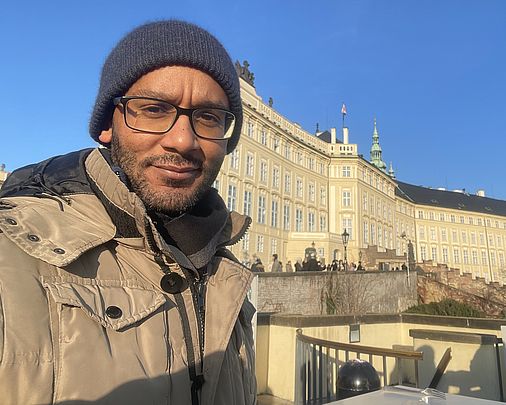
For Dr. Elisa Manzo, the connections to Regensburg regarding her research topic were not as clearly visible from the beginning: Elisa, born and raised in southern Italy, studied in Naples and did her PhD on Orosius, a late-antique theologian and historian, in a joint programme between Italy and Spain. Originally having been trained in medieval history, Elisa has a slightly different background, not only regarding her current research topic, but also regarding many scholars at the Centre. Still, she feels like having a strong and longer connection with the UR. She first read about the university during her Master’s studies around 2015, already within the context of Orosian studies: Adolf Lippold, 1968–1994 professor of Ancient History at UR, is considered to have been one of the leading Orosian scholars. Elisa’s doctoral supervisor from Naples, Prof. Luca Arcari – a former fellow of “Beyond Canon_” himself – got in touch with Tobias Nicklas. It was through this connection Elisa then had the opportunity to come to Regensburg for one year as a “Margarita Salas” Postdoctoral Fellow from the Department of Historical Sciences at the University of Cantabria in Santander, Spain, (the fellowship is financially supported by the Spanish Ministry of Universities and the EU “Next Generation funds”), taking with her the project on the Reception of Apocalyptic Literature in Orosius’s works. Apocalyptic literature and its reception are also research topics the CAS focuses on. For Elisa, the CAS was the ideal place to work, to get in touch with experts in the field to receive feedback, advice, and comments from biblical and theological scholars – but also from a personal point of view. She describes her experience as “full circle”, since working on Orosius at the UR felt to her like bringing Orosius back home. Thus, she states the UR as a whole has a very important meaning to her as a scholar. The often-emphasized agglomeration effects and the fruitful networking of the Centre worked quite well for Elisa on another level, too: the directors of “Beyond Canon_” suggested Elisa to the organizers of the interdisciplinary lecture series “Antike Weltuntergänge,” where she had the opportunity to open the series in October 2023 with a fantastic talk. This chance to speak not only about the lesser-known Orosius, but first and foremost to present her own research in different contexts, made her time in Regensburg a very positive experience, Elisa states. The fact that she could increase her visibility as a scholar and make herself more noticed is yet another thing Elisa considered very valuable about her stay at CAS: people now know about her and her project, she could make connections and broaden her own network, and even create the foundations for future projects and collaborations, like organizing a panel at the prestigious International Conference on Patristic Studies that takes place every four years at Oxford University in the UK. “In Regensburg, I found motivation and support to take on as big a proposal as the one for Oxford – and I also found the right people here at the Centre to work with on this dream of mine and make it come true! The Centre actually was the core of the proposal. So, in the end, my stay here was overall beneficial.”
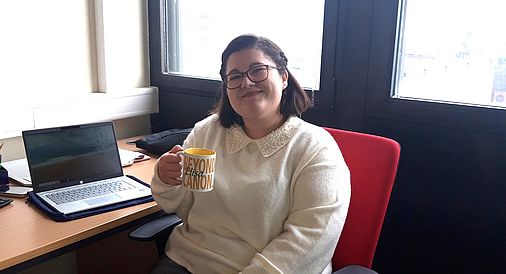
The Centre’s networks lead to further opportunities
Not only the local network of theologians, biblical scholars, and many more who were present in Regensburg made the stay worthwhile for Elisa. There opened up many other possibilities to broaden the circles: Elisa and Dr. Jacob A. Lollar, a postdoctoral researcher from the US with a research project financed by the Alexander von Humboldt-Foundation, were among a small group of people from the Centre who went to Glasgow to join a workshop organized by scholars from the University of Glasgow, the University of Oslo, and “Beyond Canon_” – a network that has proven to have the potential to grow into a longer-standing connection with many plans for future joint ventures.
Jacob learned about Regensburg and the CAS also through another former fellow of “Beyond Canon_”, Prof. Janet E. Spittler, who has a long history with the UR, having visited Regensburg multiple times: before the Centre existed, she also came as a Humboldt fellow to the UR and had nothing but praise to say, as Jacob remembers. While a postdoc in Texas, Jacob met Janet at a huge international conference around 2019 while she was a fellow at UR and allegedly told him: “I am going to plan out the next few years of your life” – and that planning proved to be successful. Prof. Nicklas also attended this conference, talking about Apocrypha and the CAS – “and the rest was kind of history,” Jacob states. Contacts developed into deeper support with project applications, and in 2021 Jacob was officially granted the funding for his next project by the Humboldt foundation. After spending some time in Paris during his PhD years, for Jacob and his family the idea of moving abroad again was very attractive, and so they made the transition to Regensburg in 2022. “It’s been a great journey,” Jacob says. “One of the things that is the highlight for me being at the Centre and at UR is the connections that I’ve been able to make: I never could have anticipated how many amazing people I would meet here. That was not my experience at all when I was in France. Everyone is so welcoming here. And the connections I’ve made especially with the people I’ve met from Oslo and Glasgow have helped me with applying for further research grants: it was actually through the help and encouragement of people like Garrick Allen and Hugo Lundhaug who helped me with my successful application for the British Academy, and hopefully – if I will go into this direction – of an ERC grant. These, among many others, have just been phenomenal connections, both on a personal and professional level.” This makes it clear: the network of “Beyond Canon_” is not limited to Regensburg.
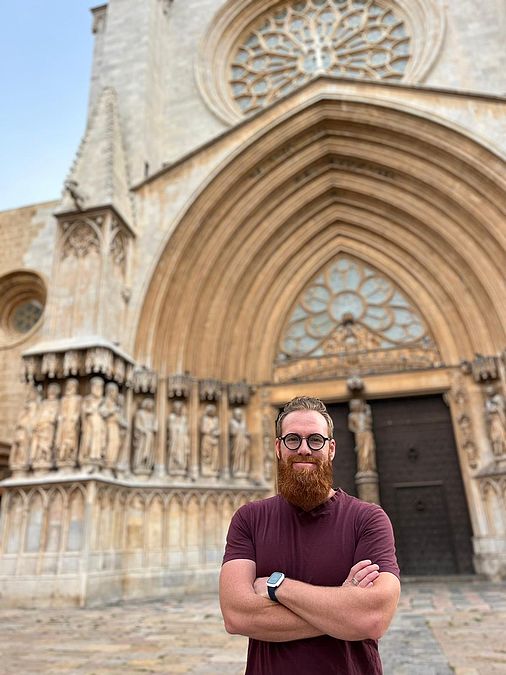
The Centre radiates outside, but also inside of UR: CAS, the Faculty of Catholic Theology, and Medieval Art History
But also within the UR, the CAS has connecting forces, for example with the chair of Liturgical Studies of Prof. Harald Buchinger, one of the Centre’s directors. Dr. Martin Lešák, who is a postdoctoral fellow of the Humboldt-Foundation at the Faculty of Catholic Theology, shares his insights with us. Martin, originally from Czech Republic, adds Art History in the mix, having authored a dissertation on the interconnections between mosaic decorations of early medieval Roman churches and the stational liturgy of the city. Through his work on this topic, Martin connected with Prof. Buchinger who encouraged him to apply for the Humboldt Research Fellowship and supported him in the process. “After completing my PhD, I saw this as a remarkable opportunity to delve deeper into liturgical sources and history, and thus far, being here at the department of Liturgical Studies has really proven to be an enriching experience. This is also thanks to the “Beyond Canon_” Centre and its interdisciplinary nature. Since I have been at the UR, I listened to excellent art historical papers presented within the framework of the Fellows’ Brunch sessions organized at the CAS. For example, a talk on San Giovanni a Porta Latina in Rome by Prof. Sible de Blaauw, who has been a fellow at the CAS multiple times, and of course, Prof. Rina Talgam’s fascinating paper on the floor mosaics in the ancient synagogue of Huqoq (Lower Galilee) stuck in my mind,” Martin states, and continues: “so I am truly glad that these Fellows’ Brunches are taking place. On one hand, they broaden my perspective by exposing me to subjects that are slightly outside my focus are. On the other hand, they provide me with papers that are pertinent to my own research, offering fresh perspectives and innovative approaches.” Martin also underlined the well-connectedness of the Faculty of Catholic Theology and the CAS: the content and the events created at the Centre are well promoted at the faculty, and people are invited to join interdepartmentally, an intertwining he appreciates very much. As a young scholar, he finds immense value in gathering interdisciplinary perspectives and contacts, which he believes inspire him even further, fuelling the creation of intriguing new ideas.
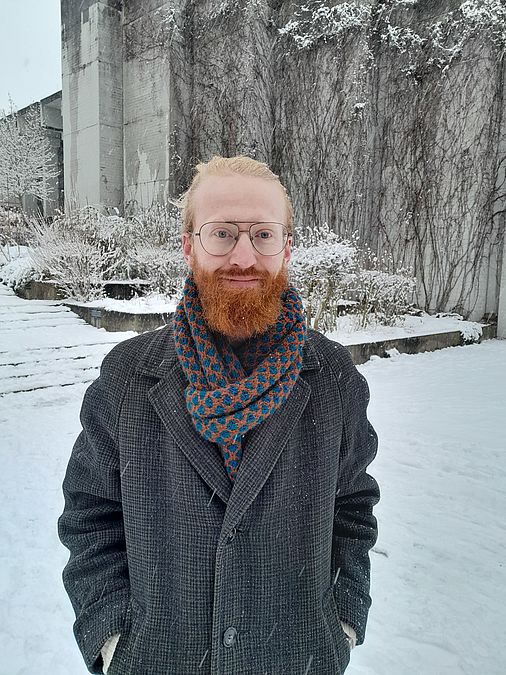
Elisa seconds that, “I studied Medieval history and then, during my PhD, I specialized in history of Ancient Christianity, so I don’t have a background in theology or Biblical Studies. When I decided to start a project on Orosius’s exegesis, I was aware that any field has its own method, issues, and research questions. For this reason, I think that in my case it was important to start my research in the vicinity of a theological faculty, being surrounded by experts in the field who could guide me through research questions, through important topics, the reception of the Book of Revelation or Apocalyptic Literature more in general. For me, starting the project in Regensburg at CAS was extremely important because it was like creating the basis for the building I am supposed to construct with the continuation of my project, and I felt very grateful and also very inspired by all the projects my colleagues are working on and how brilliant they are. This also gave me the stimulus to always do my best, to be curious. I believe starting the project so close to a theological faculty really was the best choice because I learnt a lot for my research. It was extremely helpful.”
Martin Lešák was also able to broaden his network in another direction: Prof. Buchinger brought him in touch with Prof. Albert Dietl, the only remaining professor of art history specializing in medieval art at the UR. Dietl’s research area, which includes the church of Santa Cecilia and its medieval frescoes, aligns with Martin’s interests; he feels they both share a passion for early medieval history and visual culture of Rome, in this context referring to Dietl’s previous tenure as a visiting professor (Richard-Krautheimer-Gastprofessur) at the renowned Bibliotheca Hertziana (Max-Planck-Institut) in 2005/2006. “I am happy to share that Prof. Buchinger, Prof. Dietl, and I are preparing a seminar for the upcoming summer term focusing on art and liturgy in medieval Rome. I am genuinely looking forward to this opportunity and am hopeful that the seminar will be a success.” Martin concludes.
The Danube connects Regensburg with the world
When it comes to living in Regensburg, many were surprised by the outdoor culture practiced here: “people love being outside, going for a walk, hiking, biking, strolling, just enjoy sitting outside, be it in a beer garden or on a park bench,” Jacob noticed. He also appreciates the slower life pace and friendliness of people here. The habit to be outside, enjoying life outside, is also highlighted by Luc. For his family, it was striking to find a good infrastructure regarding playgrounds for the kids, children-friendly places etc. But it is the vicinity to the river Danube that Luc probably enjoys most: living next to this stream, connecting so many European cities with Regensburg, provides an international feeling as well. As Luc says, “being in Regensburg really re-shaped my mindset being from Western Europe, from Geneva, and now being so connected to the Eastern part of Europe with Prague close by, for example – this is really something great I will take with me for the rest of my life, just to be maybe more open. The first time I ever saw the Danube was in Belgrade, by the way! Which is funny because many fellows from Serbia are at CAS. Regensburg feels a little bit like a place in between. And the Centre showed me the great world of the exegetes in Eastern Europe which I very much appreciate and feel it’s crucial to the city of Regensburg and its identity.”
Martin also acknowledges the significance of the river as an element which shapes the pleasant cityscape and encourages people to stroll and relax along its banks. Additionally, he was struck and surprised by the impactful presence of the university’s brutalist architecture. Reflecting further on the city, he remarks that “even by Czech standards, Regensburg’s rich beer culture, boasting several breweries, is something quite special.”
Regarding the famous claim that Regensburg thinks of itself as the northernmost Italian city, Elisa states this is a claim that has never reached southern Italy, where she is from. For her, Regensburg is a special place in itself, with nothing to envy Italy for. The location in Bavaria is what makes it unique for her. “I am more a fan of local identity than borrowing labels from outside or other places,” she explains. “Regensburg has a lot to offer, and that was actually very surprising to me, because as Italians, we know Regensburg mainly for Pope Benedict XVI., as a diocese, as a catholic place. But after one year in Regensburg, I realized that there is really a lot to do, you never get bored. There’s a lot of green space, many social and cultural activities, many of them organized by the university’s amazing Welcome Center, so there’s also a good connection and synergy between the city and the university. Therefore, I felt completely involved in the daily city life of Regensburg. As an Italian I appreciate more the Bavarian or German experience here.”
People and books: the Centre’s network and library are its greatest assets
Jacob remembered he had to make hard choices which books to take to Germany from his home in the US. The majority of them he left behind for the time being, what he brought were many of his necessary and therefore crucial Syriac primary texts. But still, he found himself quite surprised by finding a lot of resources here – both in terms of books and in terms of people, for example Prof. Buchinger’s expertise in Syriac and meeting Dr. Mari Mamyan, an Armenian scholar with complementary expertise – that was something he was not expecting at all. “That was a great surprise and delight,” he states, “the amount of collaboration, help, and collegiality has been incredible: having found allies in scholarship to rely on for, basically forever, has been wonderful.”
Course: Greek Palaeography II / Dr. Giulia Rossetto (NOT hybrid)
Dates: 30 November 2023–1 December 2023 / 14 December 2023–15 December 2023
Brief description: The goal of this course is to analyze the Greek scripts which were in use between the 13th and the late 16thcentury. It will begin by offering an overview of the main tools (printed and digital) we have at our disposal for the investigation of Greek manuscripts; an overview on the evolution of the Greek writing in the given time span will follow. Students will then learn how to read and transcribe various specimina of hands originating from different geographical locations. We will focus in particular on archaizing scripts, colophons, possession notes and monocondylia.
For the location of the course please ask Gregory Tucker (Gregory.Tucker@ur.de), who is helping to organize the class! As far as the deadline for registration is concerned, it would be great if you’d register with Giulia Rossetto (giulia.rossetto@univie.ac.at) before November 15th, 2023.
Times: 30 November 14:30–17:30 and 1 December 9:00–17:30
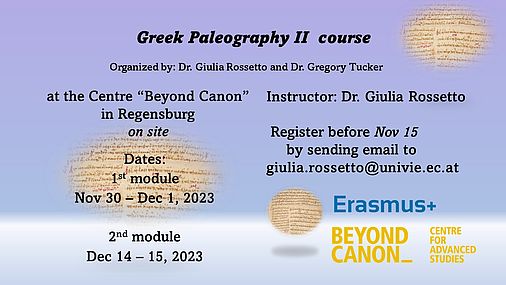
19.10.2023
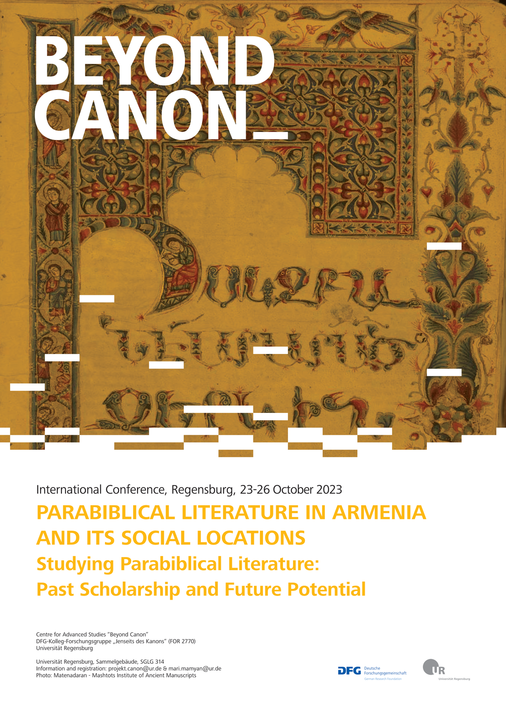
Internationale Tagung:
‘Parabiblical Literature in Armenia and its Social Locations (Studying Parabiblical Literature: Past Scholarship and Future Possibilites)’.
Regensburg, 23–26 Oktober 2023
The Armenian parabiblical heritage is impressive. From the fifth century until early modern times various parabiblical texts translated and written directly in Armenian comprised an important portion of Christian literature. When examining overwhelmingly Armenian manuscript transmission, we find no distinction drawn between apocryphal works related to Old Testament traditions and those related to the New. The Armenians manifested keen interest in patriarchs, kings, prophets from the Hebrew Bible, and in Jesus, his family and Apostles from the NT: thus the unitary concept of history was understood from Creation to Parousia and Eschaton; from Adam’s sin and fall, through the life, death and resurrection of Christ and coming to an end in the Parousia.
As the manuscript evidence shows, the border between canon and beyond canon is quite unclear in Armenian tradition. We may identify a category of parabiblical works that are often associated in manuscripts with the Bible frequently considered as semi-canonical in Armenian. The second category of Armenian parabiblical compositions are found sometimes in biblical manuscripts but they are more often copied in other types of manuscripts including hagiographic and homiletic works. Interestingly, however, there are also numerous parabiblical texts that never occur in the codicological unity with biblical canonical texts but their frequency in other types of manuscripts is remarkable.
Based on biblical and other related texts excluded from the canon, parabiblical tradition in Armenia expanded significantly reusing the biblical motives anew. The medieval Armenian society and culture viewed the bible-related knowledge and tradition as a story reflecting their own history. As a result, in parabiblical traditions emerging in Armenian, the geneology, history and geography of the Armenian people was rooted in, connected with, or identified with biblical history and geography.
The abundance of witnesses shows explicitly the vitality of the parabiblical traditions in medieval Armenian culture. Through centuries, these traditions incorporated in scholastic texts, biblical epitomes, poetic retellings dealing with biblical figures and events. Another facet of the parabiblical tradition is Armenian folklore, biblical persons and incidents became subjects of folk tales which were alive in Armenian culture over the centuries. And of course, much of Armenian art was devoted to biblical subjects where often parabiblical elements penetrate standard/canonical Gospel scenes.
Anbei finden Sie das aktuelle Programm.
Bei weiteren Fragen, wenden Sie sich an unser Team!
26.06.2023
Internationale Tagung zum Johannesevangelium in mittelalterlicher Rezeption" in Zürich mit "Beyond Canon_" (22.-25. Juni 2023)
Das Johannesevangelium in seiner vielfältigen Rezeption im europäischen Mittelalter war das Thema einer internationalen Tagung, die vom 22.–25.6. in Zürich veranstaltet wurde, gemeinsam organisiert von Prof. Dr. Jörg Frey (Theologisches Seminar) und Prof. Dr. Carmen Cardelle (Seminar für Griechische und Lateinische Philologie), beide Universität Zürich, und Dr. Stephanie Hallinger, wissenschaftliche Koordinatorin des Centre for Advanced Studies „Beyond Canon_“. Im Mittelpunkt stand die Erforschung der Rezeptions- und Wirkungsgeschichte dieses Evangeliums innerhalb unterschiedlicher Disziplinen. Fünfzehn Wissenschaftler:innen internationaler Hochschulen präsentierten ihre Forschungen dazu. Einen Höhepunkt stellte dabei der öffentliche Abendvortrag von Prof. Dr. Volker Leppin dar, der von der Yale Divinity School angereist war.
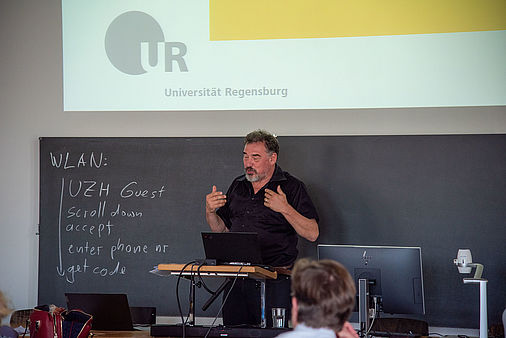
Rezeption von und Spiel mit biblischen Motiven und Themen
Prof. Frey skizzierte in der Einführung sein eigenes Forschungsinteresse. Im Rahmen des Projekts einer Kommentierung des Johannesevangeliums unter Berücksichtigung seiner immensen Wirkungsgeschichte sei die Bibelwissenschaft hier auf den Dialog mit Spezialisten anderer Fächer und Epochen angewiesen. Es gehe darum, in interdisziplinären Dialog zu treten und von den anderen Kolleg:innen zu lernen. Der Tagungsort, das Theologische Seminar der Universität Zürich im Kreuzgang des Grossmünsters, sei für einen solchen Dialog geradezu prädestiniert, denn hier begann in der Reformationszeit 1525 das gemeinsame Projekt der Zürcher Bibelübersetzung durch Theologen und Klassische Philologen aus dem Geist des Humanismus. Biblische Themen seien bis in die Gegenwart weit über die kirchliche Sphäre hinaus wirksam und auch im Mittelalter in ganz unterschiedlichen Textsorten und Medien aufgenommen worden. Aus diesem Grund sei die interdisziplinäre Zusammenarbeit verschiedener wissenschaftlicher Fächer so bedeutsam.
In der Bibelwissenschaft sei die Rezeptions- und Wirkungsgeschichte allerdings eher ein relativ junges Phänomen. Während in den Anfängen, nach dem Zweiten Vatikanischen Konzil, etwa im Projekt des „Evangelisch-katholischen Kommentars“ vor allem die Verständigung über die Konfessionsgrenzen hinweg im Zentrum stand, werde heute ein viel breiterer kulturgeschichtlicher Rahmen berücksichtigt, in dem die Bibel als Grundlage der abendländischen Kultur erforscht werde.
Johannesevangelium – das „geistige Evangelium“
Neben der Apokalypse sei das Johannesevangelium der Text mit der breitesten Rezeption, mit einer Wirkung weit über kirchliche und theologische Kontexte hinaus. Es verfüge neben dem theologischen Gehalt über eine narrative Eigenständigkeit, eine eindrückliche Metaphorik sowie eine eingängliche Sprache, und seit Clemens von Alexandrien wurde es aufgrund seiner Besonderheiten als das „geistige Evangelium“ bezeichnet. Die Wirkung der Johanneischen Figuren reichte daher ebenfalls weit über den theologischen Kontext hinaus in Literatur, Musik und bildender Kunst. Das Bild des sogenannten „Guten Hirten“ beispielsweise sei von großem Einfluss gewesen auf die Frömmigkeits- und Mentalitätsgeschichte, ebenso die Darstellung des „Lieblingsjüngers“ Johannes mit der Mutter Jesu in den bildhaften Darstellungen der Kreuzigung. Daher seien in der Erforschung der Wirkung des Johannesevangeliums stets in breiter Interdisziplinarität und Intermedialität die Literatur und die Bildende Kunst mit einzubeziehen, wie dies auch in der Planung dieser Tagung vorgesehen wurde.
Auch Prof. Dr. Carmen Cardelle betonte die dramaturgische Bedeutung des Johannesevangeliums, die sie als eine der Ursachen für die starke Wirkungsgeschichte dieses Evangeliums hervorhob. Dessen vielfältige Wirkung im Mittelalter wolle man mit dieser Tagung erkunden und weiter erforschen, und zwar über die Theologie hinaus durch die Einbeziehung von Literatur- und Liturgiewissenschaft, Kunstgeschichte, Architektur und Archäologie.
Apokryphen und Johannesevangelium vermischen sich
Der Beitrag von Prof. Dr. Ulrich Eigler (Lateinische Philologie, Universität Zürich) widmete sich dem Pilatuswort „quod scripsi scripsi“ („Was ich geschrieben habe, das habe ich geschrieben“). Dieses Wort aus der johanneischen Passionsdarstellung eröffnete einen weiten Fragenkreis im Blick auf spätere Passionsdarstellungen und Passionsspiele, die oft stark auf Johannes rekurrierten, daneben aber auch auf apokryphe Traditionen wie das beliebte Nikodemusevangelium. Es sei davon auszugehen, dass beim Publikum die Kenntnis solcher Schriften und Traditionen vorhanden war. Auch die anachronistische Darstellung von Handlungssträngen in den Spielen setzte einen gefestigten Wissensstand voraus, ebenso die absichtliche Unterscheidung zwischen inner- und außertextlicher Kommunikation, bei der Leerstellen – als Beispiel diente Jesu Titulus „INRI“ am Kreuz – bewusst als Kommunikationsräume verwendet worden seien, die durch das Publikum bzw. die Leserschaft selbst mit Sinn gefüllt werden sollten. Die Leserschaft/dem Publikum komme also in diesem Falle die Funktion zu, die vollständige Geschichte zu (re-)konstruieren.
Weitere Vorträge beschäftigten sich mit der Rezeption des Johannesevangeliums in der spätantiken lateinischen Bibelepik (Dr. Hedwig Schmalzgruber, Universität Graz), sowie im Evangelienbuch (Liber evangeliorum) des Otfried von Weissenburg (um 790–875), den Prof. Dr. Christina Hoegen-Rohls (Universität Münster) als denjenigen Autor bezeichnete, der den „Beginn der deutschen Philologie“ markiere und in dessen Evangelienbuch eine Kommentierung, Auslegung und Interpretation des Johannesevangeliums stattfinde.
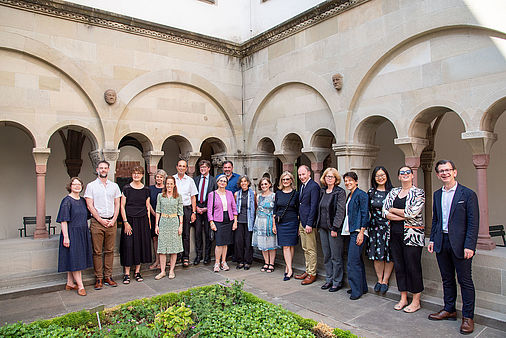
Das Johannesevangelium in der mittelalterlichen Frauenmystik, in der „Legenda aurea“ und im „Irischen Bibelwerk“
Bei seinem öffentlichen Abendvortrag befasste sich Prof. Dr. Volker Leppin (Yale Divinity School) mit „Geist und Körperlichkeit in der mittelalterlichen Frauenmystik“ anhand der Mystikerinnen Margarete Ebner, Mechthild von Magdeburg, Mechthild von Hackeborn und ihrer Schwester, der Äbtissin Getrud von Helfta. Letzterer erschien Johannes in priesterlichem Gewand als eine mystische Begegnung mit Gott; daraus folgerte sie: Wenn ein priesterlicher Bezug mystisch erfahrbar sei, werde die Person des Priesters überflüssig. Die Mystikerinnen nahmen in ihren Erscheinungen und Erlebnissen verschiedene Rollen ein, die die binären Geschlechtergrenzen überwanden, ebenso Johannes und Jesus selbst – aktuell könnte man dafür Termini wie genderqueere Fluidität verwenden: Gott ist weder Mann noch Frau, was den Mystikerinnen des Mittelalters durchaus bewusst war.
Nach einem Vortrag über die Auslegung eines Verses des Johannesevangeliums durch Meister Eckhart (Prof. Dr. Julie Casteigt, Universität Toulouse) schloss Prof. Dr. Barbara Fleith (Universität Genf) mit einer Präsentation zu „Spuren des Johannesevangeliums in der ‚Legenda aurea‘“ an, einem der zitatenreichsten Texte des Mittelalters, und griff am Beispiel der dort ausgeführten Johanneslegende auf die angesprochene Überwindung von Gendergrenzen zurück: Johannes sei als „virgo electus“ verstanden werden, denn er habe nach der Hochzeit zu Kana seine Braut verlassen, um Jesus zu folgen, sodass er seinerseits zur Braut Jesu geworden sei. Ihm sei es erlaubt gewesen, an der Brust des Herrn zu ruhen, um am heiligen Quell „trinken“ zu dürfen, also Jesus besondere Informationen zu entlocken.
Dem Johannes-Kommentar im sogenannten „Irischen Bibelwerk“ widmete sich Dr. Lukas Dorfbauer (Universität Salzburg). Dieses bislang fast unbekannte, umfangreiche Sammelwerk von Einzelkommentaren zur gesamten Bibel wurde wahrscheinlich im 8. Jahrhundert in einem irisch geprägten Umfeld entweder auf den britischen Inseln oder auf dem europäischen Kontinent verfasst und weist zahlreiche Parallelen zu zeitgenössischen populärsprachlichen irischen Texten auf. Die Rezeption des Johannesevangeliums erfolge hier vor allem über eine Epitome des Kommentars des Augustinus, sodass faktisch eine „Rezeption der Rezeption“ vorliege.
Johannes als Kirchenpatron, Prachteinbände und Passionsfeiern in der Liturgie und außerhalb
Prof. Dr. Carola Jäggi (Universität Zürich) befasste sich mit sakraler Architektur unter dem Patrozinium des Evangelisten Johannes. Ein Beispiel war San Giovanni Evangelista in Ravenna, eine Kirche aus dem 5. Jahrhundert, in Auftrag gegeben von Galla Placidia während ihrer Regentschaft über das Weströmische Reich. Die Kirche befand sich ursprünglich wohl näher am Hafen von Ravenna, was unter anderem auch das Patrozinium erklären könnte, da der Evangelist Johannes auch als Erretter der Ertrinkenden bzw. Retter in Seenot angesehen wurde: Galla Placidia geriet bei einer Schiffsüberfahrt selbst in Gefahr und überstand diese. Die zerstörten Mosaike zeigten wohl auch eine Darstellung der in Seenot geratenen Galla Placidia.
Mit Prof. Dr. David Ganz (Universität Zürich) wurde der Fokus auf die Buchmalerei gelegt, konkret auf den Johannesprolog in der mittelalterlichen Buchkunst. Ganz wies auf die hohe Bedeutung der Prachteinbände der in der Liturgie verwendeten Evangeliare hin und nannte als Beispiele den Codex Aureus von Echternach (11. Jh.), das Evangeliar Heinrichs des Löwen und Mathildes von England (12. Jh.) oder auch das Lindisfarne-Evangeliar (8. Jh.). In Illuminationen mittelalterlicher Manuskripte wurden die vier Evangelisten oft mit ähnlicher Physiognomie dargestellt. Dennoch kam dabei Johannes eine etwas herausgestellte Rolle zu, denn er wurde meist nicht mehr schreibend dargestellt, sondern mit dem bereits fertigen Buch; im irischen Book of Kells (um 800) könne die Johannes-Darstellung gar als Angleichung an die Darstellung Christi verstanden werden, indem mit Kreuznimbus und Mandorla ikonographische Mittel verwendet wurden, die im Allgemeinen für Christus „reserviert“ waren.
Die Beiträge von Prof. Dr. Regina Toepfer (Universität Würzburg) und Prof. Dr. Harald Buchinger (stellv. Direktor von „Beyond Canon_“ sowie Lehrstuhlinhaber Liturgiewissenschaft, Universität Regensburg) widmeten sich den zusammenhängenden Themen der mittelalterlichen Passionsspiele einerseits sowie der liturgischen Dramatisierung des „Planctus Mariae“ in der mittelalterlichen Passions- und Osterliturgie. Buchinger skizzierte anhand zahlreicher Beispiele aus der Liturgie die dramatische Ausweitung der Figuren der Mutter Jesu und des Lieblingsjüngers unter dem Kreuz sowie der Magdalena am Grab, womit sich in der Liturgie Intertextualität, Intermedialität und Performanz zeige. Die Passionsspiele des Mittelalters, außerhalb des kirchlichen Rahmens im Raum der städtischen Öffentlichkeit und oft durch einen ausgeprägten Antijudaismus gekennzeichnet, fungierten nach Toepfer gar als Massenmedien, durch die das biblische und außerbiblische Narrativ dramatisiert, aber auch emotionalisiert und popularisiert wurde. Dabei sei die Rolle des Apostels Johannes in den Spielen gegenüber der biblischen Tradition teilweise erweitert, während in anderen Spielen sogar zwischen dem Apostel und dem (erläuternden Text des) Evangelisten differenziert wurde.
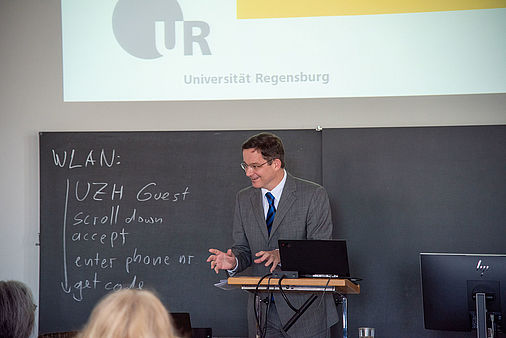
Was ist der Unterschied zwischen Rezeptions- und Wirkungsgeschichte?
Nach weiteren Präsentationen und Vorträgen knüpfte die Abschlussdiskussion wieder an Fragen an, die Prof. Frey bei der Begrüßung anriss: Wie lassen sich Rezeptions- und Wirkungsgeschichte definieren und unterscheiden? Ist eine Unterscheidung überhaupt möglich und sinnvoll? Die Überzeugung, dass es ein Text wert sei, überliefert, tradiert und benutzt zu werden, stelle bereits eine Rezeption dar, so Frey. Barbara Fleith verwies dabei auf apokryphe und hagiographische Schriften und Traditionen, die oft im Sinne einer Rezeption der Rezeption miteinzubeziehen wären. Prof. Dr. Greti Dinkova-Bruun (University of Toronto) schloss mit der These, dass nicht nur Texte und Texttraditionen, sondern auch performative Aspekte und materiale Kulturen untersucht werden müssten und berührte damit die essenziellen Forschungen von „Beyond Canon_“, die exakt diese Bereiche fokussieren.
Mit dieser Zürcher Tagung, die maßgeblich vom Schweizerischen Nationalfonds finanziert, aber auch von „Beyond Canon_“ mitgetragen wurde, dokumentierte sich einerseits die internationale Vernetzung von „Beyond Canon_“ und andererseits das weite Feld von Fragestellungen, das sich in der Rezeptionsgeschichte biblischer Texte über den Kanon hinaus in vielen Feldern und Medien eröffnet.
(c) all Photos: Kyungmin Kim / Universität Zürich
20.05.2023
"Why do we think New testament scholarship is important?" was the overall motto of an international (post-)doctoral Colloquium and Seminar in Haus Johannisthal from May 17th-20th, 2023
A group of international emerging scholars came together at Haus Johannisthal near Weiden, Germany, from May 17th–20th, 2023, to discuss their research and the overall future of New Testament studies. Dr. Judith König, assistant at the Chair of Prof. Dr. Tobias Nicklas, Professor of New Testament Exegesis and Hermeneutics and Director General of the DFG-Centre for Advanced Studies “Beyond Canon_”, Regensburg, and Dr. David Cielontko, Czech Academy of Sciences and Charles University, Prague, organized the event. Participants came from the University of Regensburg (UR), Charles University, Prague, and from Trinity Western University (TWU) near Vancouver, Canada, under the auspices of Prof. Dr. Thomas R. Hatina, Chair of the Department of Religious Studies at TWU and Visiting Professor at Charles University, Prague.
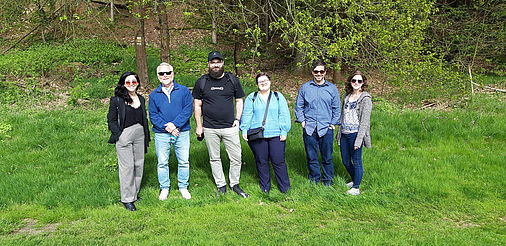 During the seminar, doctoral students and post-doc researchers presented their projects with a broad variety of topics to several young and emerging scholars as well as the professors:
During the seminar, doctoral students and post-doc researchers presented their projects with a broad variety of topics to several young and emerging scholars as well as the professors:
Stu Talene, from TWU and PhD student at Charles University, examines Marcion’s Evangelion and the composition of Luke-Acts and issued the statement, “Great authors don’t describe the world, they change it.”
Dr. Elisa Manzo, a postdoctoral fellow with the Margarita Salas Foundation in Spain, introduced the audience to the late-antique historian and theologian Orosius. In her project, Manzo combines historical, theological, and exegetical research and described her approach as walking with a torch, trying to make space between the words of Orosius’s texts and enlighten this space to discover exegetical meanings. While she pointed out, “context is always key, without forgetting the actual product.” Prof. Nicklas characterised Orosius as “an artist who painted with the medium of the bible.”
In the context of the presentation of his doctoral thesis, Marko Jovanović presented the models and theories of the parting(s) of the ways between Christianity and Judaism, the criticism of this approach which keeps being discussed controversially, and models of interlacement, concluding with a discussion about the use of models as such.
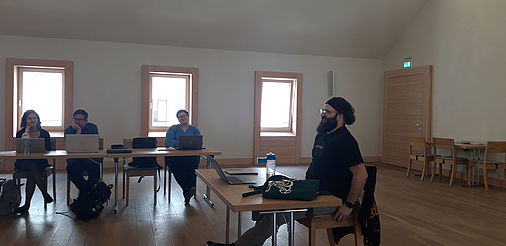 Dr. Mari Mamyan, post-doc at “Beyond Canon_” since 2019 and currently working on her own DFG-project on the Armenian Infancy Gospel, explained how comparing all possible witnesses of one text from different manuscripts and examining all variations, omissions, and additions – e.g., confusion of words graphically resembling each other or of similar sounding words – brings to light new results and aspects of the textual genesis and its variations in translations.
Dr. Mari Mamyan, post-doc at “Beyond Canon_” since 2019 and currently working on her own DFG-project on the Armenian Infancy Gospel, explained how comparing all possible witnesses of one text from different manuscripts and examining all variations, omissions, and additions – e.g., confusion of words graphically resembling each other or of similar sounding words – brings to light new results and aspects of the textual genesis and its variations in translations.
The semantic shift of the word ὥστε, from indicating result to purpose clauses and how it is used in LXX Leviticus and Greek documentary papyri, was presented by Naomi Rey, a promising emerging scholar from TWU, who is doing research on this topic within her Master’s thesis.
Dr. Judith König, former PhD student of Prof. Nicklas and now preparing her habilitation thesis research topic, proved the immense relevance of her project for society as a whole, dealing with the question of sexual autonomy in Antiquity and exploring the role of the bible, especially New Testament texts, in the context of sexual autonomy of women. The project was considered having the potential of changing the whole field of New Testament Studies: the bible was and still is used to do and justify great harm – thus, critical studies of the bible cannot be valued highly enough, and in the end, scholars do have responsibility.
With Kyle Parsons’ PhD thesis, the audience followed the tracking of negative reputations in early Christianity, e.g., with the example of receptions of the death of Judas, who can be read quite differently, as negative or tragic figure.
The all-encompassing parenthesis of the workshop was the question of relevance of New Testament scholarship today:
The competence regarding what “being human” means can be taught by the provided myths to live by as well as the revelation of us as human beings that were viewed as crucial. Critical studies of texts that can unfold danger go hand in hand with responsibilities, damage control, and the possibility of hoping to reverse harm. Understanding history through texts with a context that always needs to be taken into consideration can provide moral and ethical guidance, teach resilience against ideologies, and train social emancipation. Challenging changes with the competence to ask questions can be a way to facilitate peace.
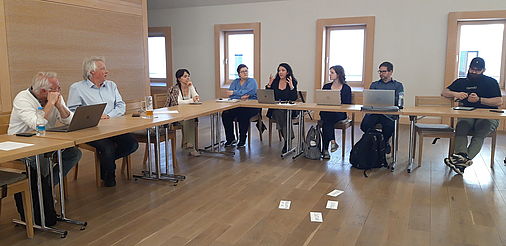 As always, also this exchange between international young researchers from different traditions and countries with the supervising professors provided an ideal opportunity for exchange beyond one's own disciplinary boundaries; the relationships established during this seminar will also be able to be used for more intensive research in the future.
As always, also this exchange between international young researchers from different traditions and countries with the supervising professors provided an ideal opportunity for exchange beyond one's own disciplinary boundaries; the relationships established during this seminar will also be able to be used for more intensive research in the future.
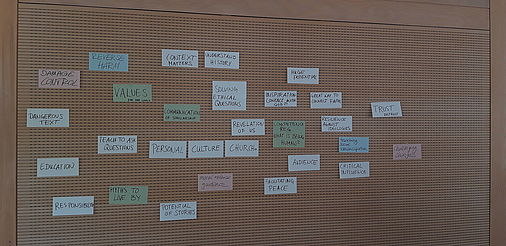
(c) all Photos: Charlotte von Schelling / "Beyond Canon_"
19.05.2023
GSCO-Preis für die Dissertation von Dr. Gregory Tucker
Dr. Gregory Tucker erhält für seine Dissertation über The Hymnography of the Middle Byzantine Ecclesiastic Rite & Its Festal Theology. Introduction - Edition & Translation - Commentary (publiziert in der Reihe Studies in Eastern Christian Liturgies 5; Münster: Aschendorff, 2023) den Preis der Gesellschaft zum Studium des Christlichen Ostens 2023.
Nach seiner Promotion im Graduiertenkolleg "Metropolität in der Vormoderne" (DFG-GRK 2337) war Dr. Gregory Tucker 2021-2022 Junior Fellow des Centre for Advanced Studies "Beyond Canon_" (DFG-FOR 2770) und ist seit 2022 Inhaber einer Eigenen Stelle der DFG am Lehrstuhl für Liturgiewissenschaft mit einem Projekt über die byzantinischen Hymnen zum Fest der Verklärung Christi.
06.04.2023
Sommerprogramm:
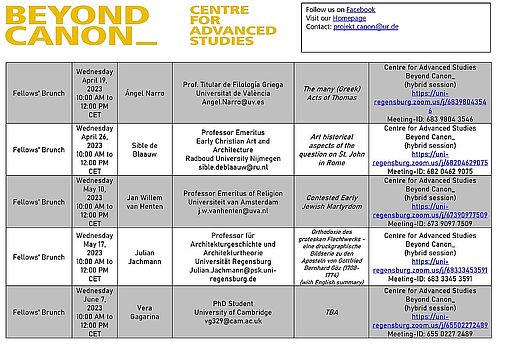
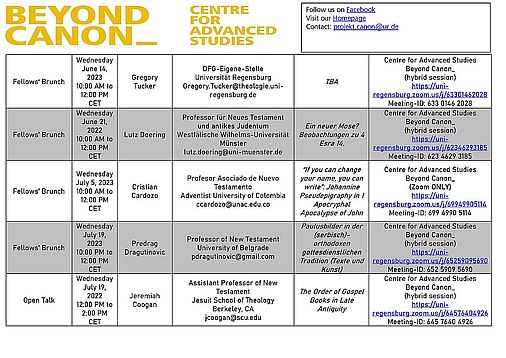
Für weitere Informationen und Updates, senden Sie bitte eine Anfrage an: projekt.canon@ur.de
01.12.2022
Meeting HTLS — Project Canon
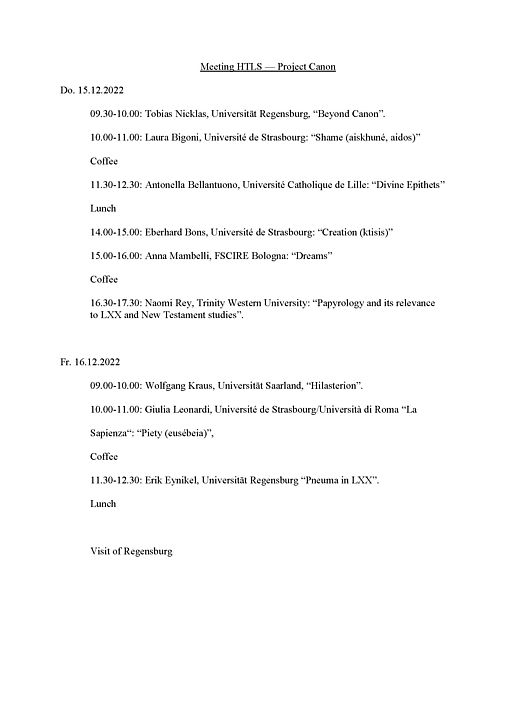
29.11.2022
Zwei neue DFG-Stellen
Wir freuen uns mitteilen zu können, dass zwei der "Beyond Canon_"-Fellows jeweils eine eigene DFG-Stelle bewilligt wurde.
Dr. Mari Mamyan wurde das Projekt "Die Thomasakten umgeschrieben: Der Apostel Thomas in der armenischen Tradition (The Acts of Thomas Rewritten: the Apostle Thomas in the Armenian Tradition)" bewilligt.
Dr. Mari Mamyan war von 2013 bis 2019 wissenschaftliche Mitarbeiterin am Institut für antike Manuskripte Mashtots' Matenadaran, Jerewan/Armenien. 2018 wurde sie an der Staatlichen Universität Jerewan promoviert. Seit Januar 2019 arbeitet sie am Zentrum "Beyond Canon_" an der "Synoptischen Edition des armenischen Kindheitsevangeliums mit drei zusätzlichen Versionen (armenischer Text und englische Übersetzung)" auf der Grundlage bisher unveröffentlichter Handschriften.
Dr. Thomas Tops wurde von der DFG das Projekt “Eine sozial-historische Studie des Wahrheit-Sprechens in den Petrus- und Thomasakten (A Social-Historical Study of Truth-Telling in the Acts of Peter and the Acts of Thomas)" bewilligt. Nach Abschluss seiner Doktorarbeit an der KU Leuven und der PThU Groningen, welche mit der Höchstnote cum laude ausgezeichnet wurde, arbeitet Tops seit Oktober 2021 am Beyond Canon Center in Regensburg an einem Buch über „Wahr-Sprechen im Johannesevangelium und den frühen Apostelakten“. In seiner Arbeit, die durch seine philosophische, philologische und theologische Ausbildung geprägt ist, kombiniert Tops aktuelle Fragen mit historischen Perspektive
Link zum Flyer
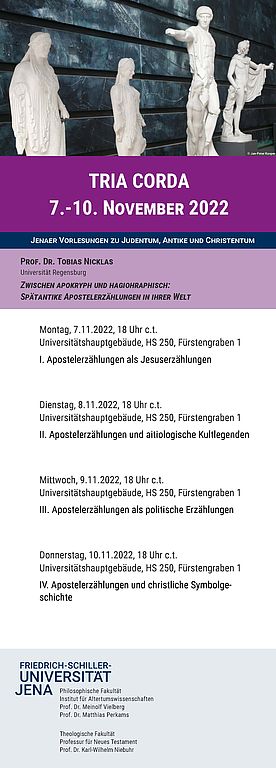
Link zum Workshopflyer
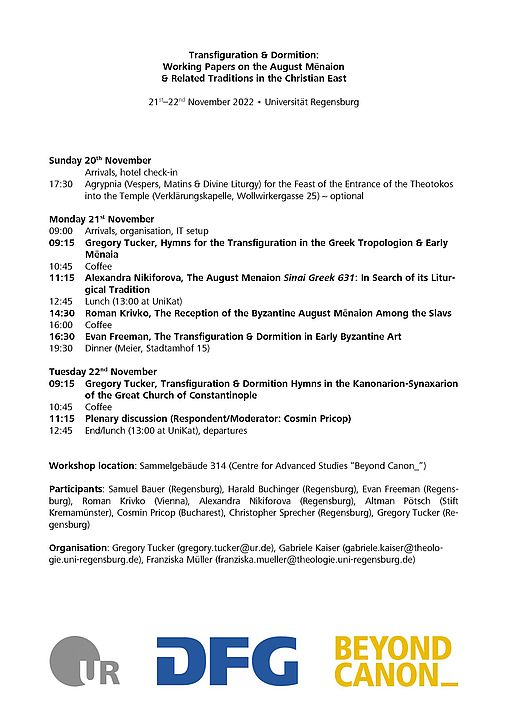
13. Oktober 2022
THE KAVANAGH LECTURE. INSTITUTE OF SACRED MUSIC, UNIVERSITÄT YALE.
Wir freuen uns mitteilen zu können, dass die diesjährige Kavanagh Lecture des Institute of Sacred Music der Universität Yale von Prof. Dr. Harald Buchinger gehalten werden konnte.
Die Lesung fand Donnerstag, 13. Oktober 2022, unter dem Titel „Deposition Rites: Dramatic Liturgy and Its Media Between East and West“ vor Ort statt.
Eine kurze Beschreibung des Talks ist in englischer Sprache auf der Homepage des Instituts des ISM zu lesen:
„This year’s Kavanagh Lecture will be given by Professor Harald Buchinger, Chair of Liturgical Studies at Regensburg University in Germany. Deposition rites, that is, ritual entombments of symbols of Christ’s dead body on Good Friday, have long been an emotional climax of Holy Week. As dramatic rituals and multi-medial representations of biblical history, they gave rise to innovative artistic, poetic and musical genres and exerted cultural influence far beyond liturgy. While deposition rites have been abandoned in the early modern reformation or recent reform in most Western churches, the Epitaphios procession is still one of the most popular services in Byzantine Christianity. The lecture will investigate the history and meaning of these prominent elements of Christian liturgy. Historically, it will be argued that the ritual may have spread from West to East and therefore against the widely assumed general trend of liturgical influence; hermeneutically, the character of mimetic rituals and their mediality will be discussed, not least in view of their theological and spiritual bearing.“
Interessierte können die Lesung via der Institutshompage nachträglich ansehen oder direkt auf YouTube einsehen.
06.-10 Juni 2022
INTERDISCIPLINARY SYMPOSIUM
THE LITURGY OF ST JAMES
Link zum Tagungsflyer
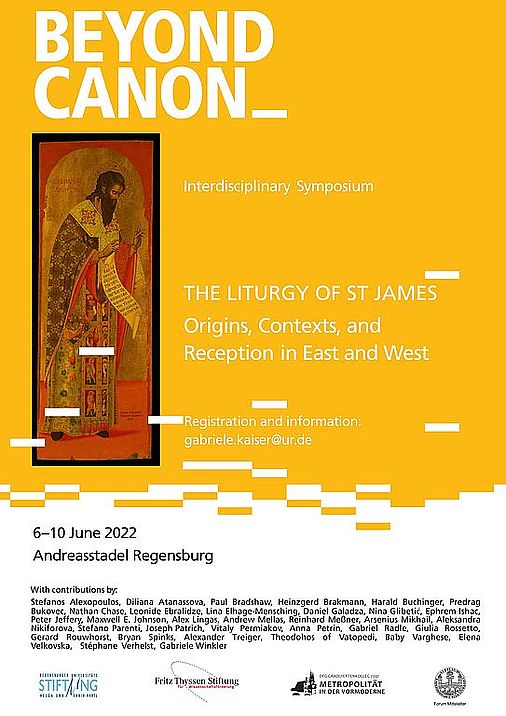
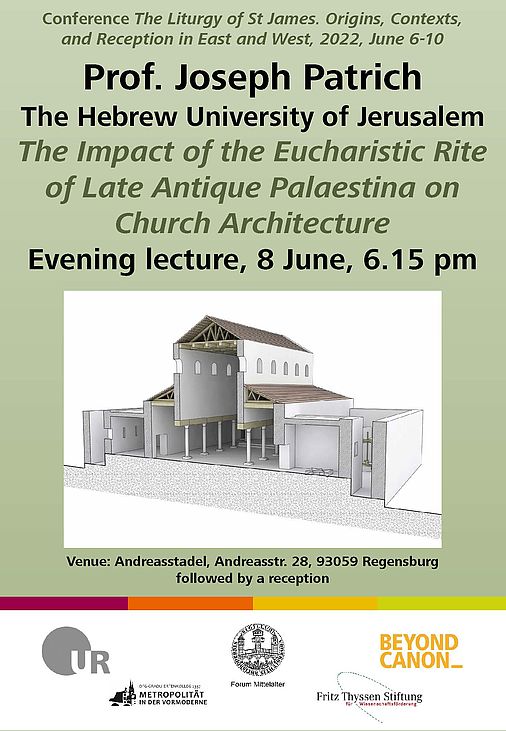
Raul Reinhardts Annahme in die Studienstiftung des deutschen Volkes
Wir freuen uns mitteilen zu können, dass Raul Reinhardt, SHK-Mitarbeiter am Centre for Advanced Studies „Beyond Canon_“, in die Studienstiftung des deutschen Volkes aufgenommen wurde. Die Studienstiftung zählt zu den renommiertesten Begabtenförderwerken Deutschlands und nur wenigen wird die Zusage - nach einem hochkompetitiven und mehrstufigen Auswahlverfahren - zuteil.
Erwartet werden neben durchgängig exzellenten Studienleistungen auch gesellschaftliches Engagement und interdisziplinäre Sensibilität. Dafür erhält man ein vielfältiges Förderangebot vom Grundstipendium über Auslandsaufenthalte und Sommerakademien bis zu einem für die weitere Laufbahn sehr nützlichem Netzwerk.
Wir gratulieren ihm von ganzem Herzen!
Novum Testamentum Patristicum Lecture by Riemer Roukema: Unavoidable haireseis in the Church. 1 Cor. 11:19 in Patristic Reception between 350 and 450 CE.
This lecture took place on Monday, 11. October 2021 and the lower attendance of this session has nothing to do with the quality of this wonderful lecture. Here follows a short abstract of the paper: "in the Greek Church, Chrysostom's historical interpretation of haireseis in 1 Cor. 11:19 as local dissensions became authoritative. In the Latin Church, haereses in this text was mainly understood as doctrinal heresies. The diverging traditions of interpretation will be discussed, including the reasons of the necessity of the haireseis." Enjoy!
Spacer
Summer School des Centre for Advanced Studies “Beyond Canon_” der Universität Regensburg in Rom, 20.–25.09.2021
“Late Antique Rome as a Christian Memorial Landscape. Extra-Canonical Texts, Liturgy, and Material Culture” lautete der Titel einer Summer School, den das Centre for Advanced Studies “Beyond Canon_” der Universität Regensburg in Kooperation mit dem Koninklijk Nederlands Instituut Rome (KNIR) vom 20.–25.09.2021 durchführte.
An den Nachmittagen stellten 13 Prae‑ und PostDocs aus den USA (Princeton und Yale University) und Europa sowie aus verschiedenen Disziplinen ihre Projekte dem Plenum – bestehend aus den NachwuchswissenschaftlerInnen selbst sowie den Professoren (Prof. Dr. Harald Buchinger und Prof. Dr. Tobias Nicklas sowie Prof. Dr. Jens Schröter von der Humboldt-Universität zu Berlin und Prof. Dr. Sible L. de Blaauw, ehem. Radboud-Universität Nijmegen und ehem. Vize-Direktor des KNIR) und OrganisatorInnen – im Auditorium des KNIR vor und zur Diskussion.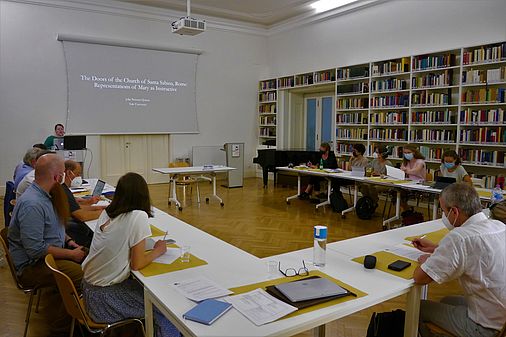
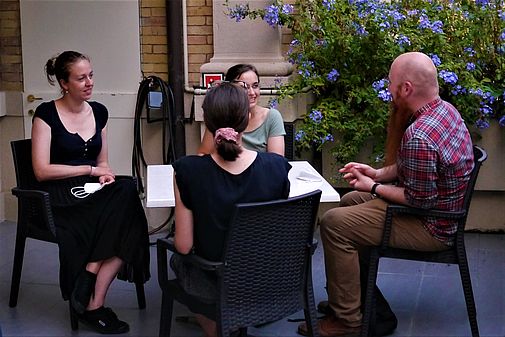 Die Vormittage verbrachte die Gruppe mit Besichtigungen der für die jeweiligen Forschungsprojekte relevanten Orte und Monumente in Rom. Die Führungen von Prof. Sible de Blaauw, dem herausragenden Experten für das spätantike und mittelalterliche Rom, wurden durch Prof. Jens Schröter und lokale Experten ergänzt. Am ersten Tag erschloss Dr. Norbert Zimmermann (2. Direktor des Deutschen Archäologischen Instituts, Abteilung Rom) die Katakomben der SS. Marcellino e Pietro sowie das Helena-Mausoleum.
Die Vormittage verbrachte die Gruppe mit Besichtigungen der für die jeweiligen Forschungsprojekte relevanten Orte und Monumente in Rom. Die Führungen von Prof. Sible de Blaauw, dem herausragenden Experten für das spätantike und mittelalterliche Rom, wurden durch Prof. Jens Schröter und lokale Experten ergänzt. Am ersten Tag erschloss Dr. Norbert Zimmermann (2. Direktor des Deutschen Archäologischen Instituts, Abteilung Rom) die Katakomben der SS. Marcellino e Pietro sowie das Helena-Mausoleum. 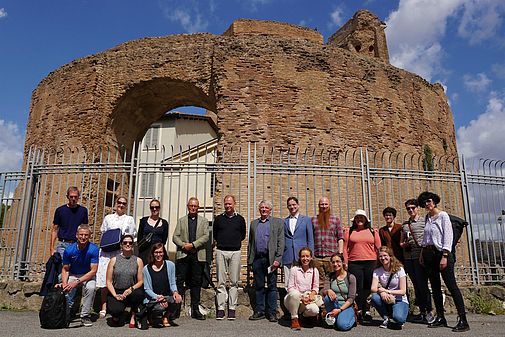 Am zweiten Tag führte Prof. Sible de Blaauw zunächst durch SS. Cosma e Damiano mit Unterkirche am Forum Romanum;
Am zweiten Tag führte Prof. Sible de Blaauw zunächst durch SS. Cosma e Damiano mit Unterkirche am Forum Romanum;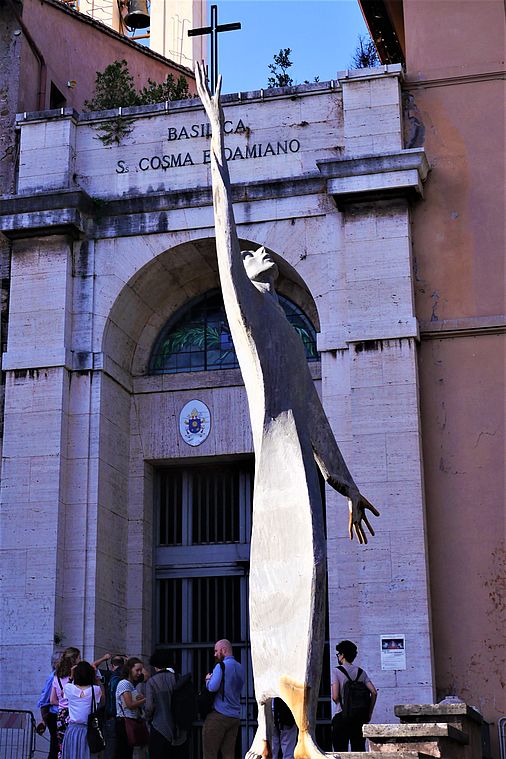
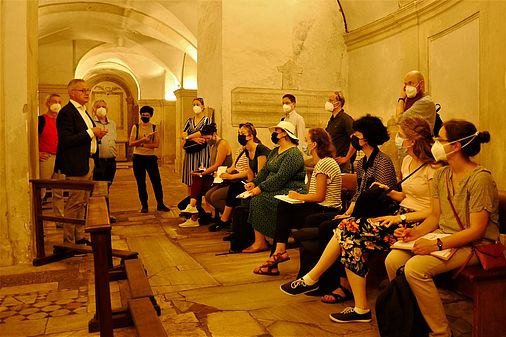
danach folgte ein ausführlicher Rundgang über das Forum Romanum mit Prof. Dr. Martin Wallraff, Lehrstuhlinhaber für Ältere Kirchengeschichte an der Ludwig-Maximilians-Universität München. 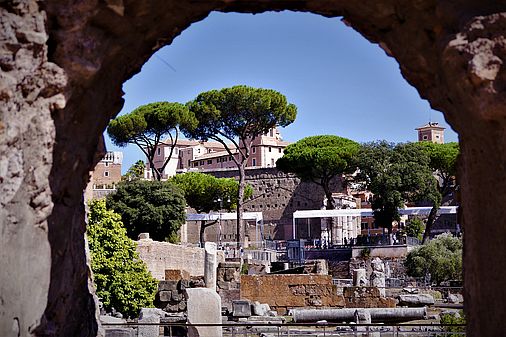
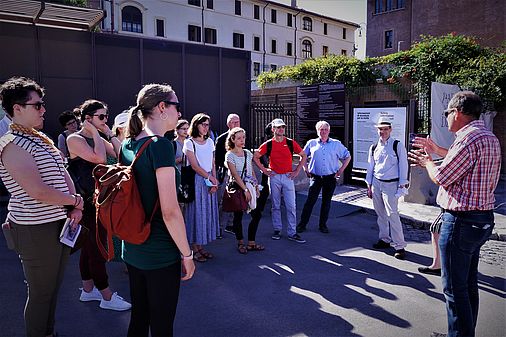
Durch S. Giovanni in Laterano sowie das dortige Baptisterium führte am nächsten Tag wiederum Prof. de Blaauw.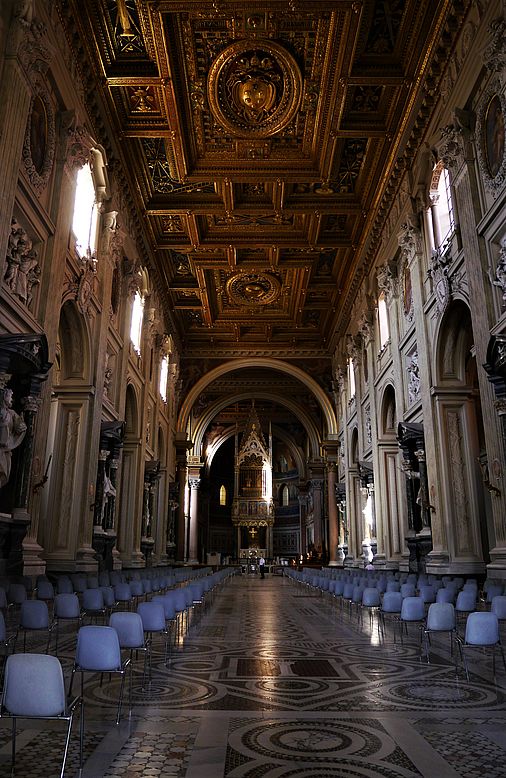
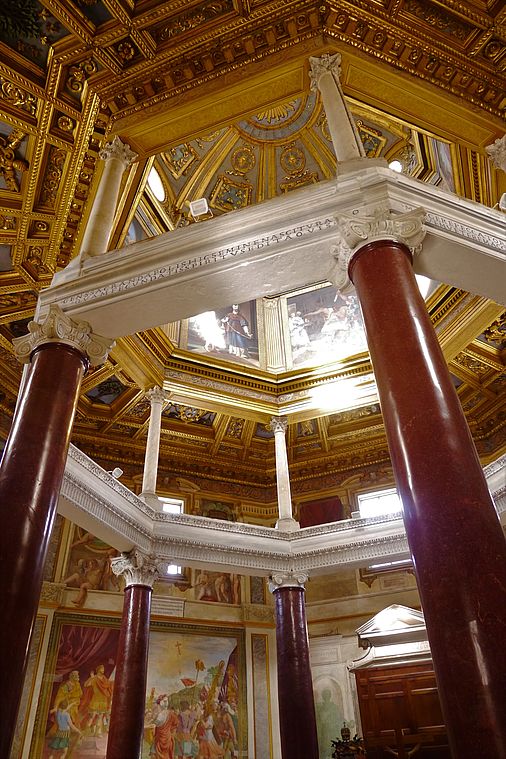 Fr. Philipp J. Wagner, O.P., Rektor der Basilika S. Sabina, öffnete uns danach trotz Sanierungsarbeiten die Türen zu Kreuzgang und Kirche, unter der sich noch Überreste von Privathäusern aus der römischen Kaiserzeit befinden.
Fr. Philipp J. Wagner, O.P., Rektor der Basilika S. Sabina, öffnete uns danach trotz Sanierungsarbeiten die Türen zu Kreuzgang und Kirche, unter der sich noch Überreste von Privathäusern aus der römischen Kaiserzeit befinden.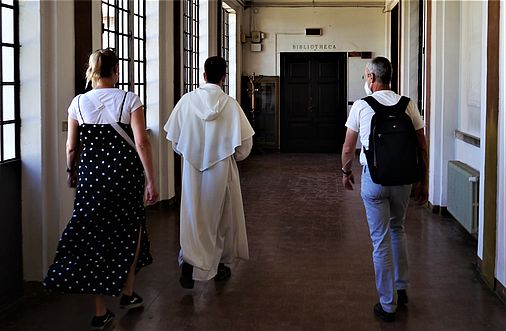

Der nächste Tag war ganz dem Vatikan gewidmet. Begonnen wurde im lange Zeit nicht vollständig zugänglichen Museo Pio Cristiano, einem Teilmuseum der Vatikanischen Museen, durch das der Hauptkurator Dr. Umberto Utro und sein Mitarbeiter Dr. Alessandro Vella führten.
Ausführliche Diskussionen entfalteten sich vor allem vor zwei Prachtsarkophagen „a doppio registro“ mit Reliefs biblischer und apokrypher Motive. Am Nachmittag wurde die Nekropole unter St. Peter besichtigt. Danach ging es nach S. Giovanni in Oleo und zur Basilika S. Giovanni a Porta Latina. Der letzte Tag startete auf der nicht öffentlich zugänglichen Loggia von S. Maria Maggiore, die neben Prof. de Blaauw auch Prof. Dr. Arnold Nesselrath, ehem. HU Berlin und ehem. Direktor der Abteilung für byzantinische, mittelalterliche und moderne Kunst der Vatikanischen Museen, erläuterte. 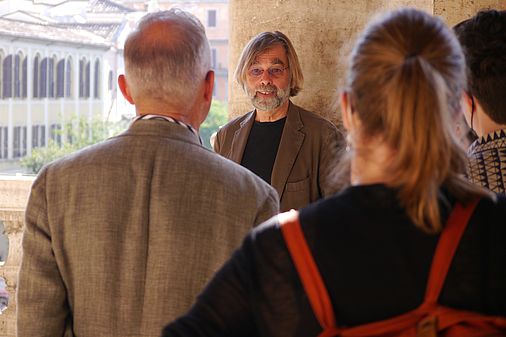
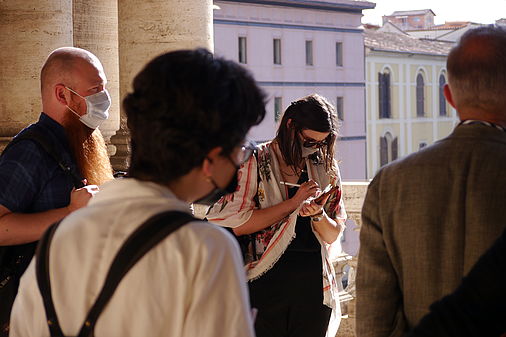 Nach der Besichtigung der Basilika selbst standen noch die nahen Kirchen S. Pudenziana und S. Prassede auf dem Programm.
Nach der Besichtigung der Basilika selbst standen noch die nahen Kirchen S. Pudenziana und S. Prassede auf dem Programm.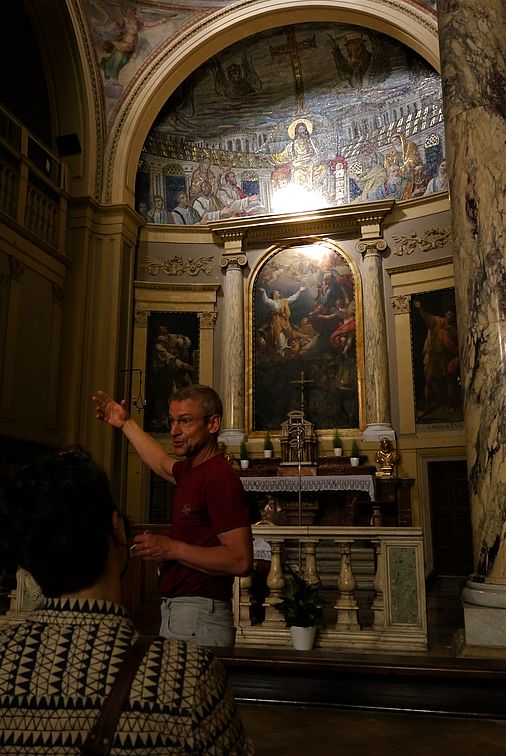
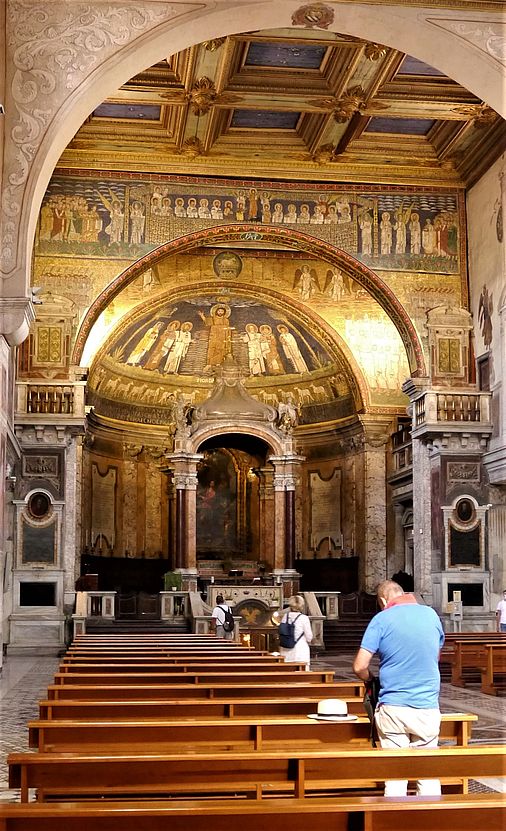
Der fakultative Besuch von S. Clemente am darauffolgenden Vormittag beschloss die Summer School in Rom.
Dieser Austausch zwischen internationalen NachwuchswissenschaftlerInnen unterschiedlicher Disziplinen mit den betreuenden Professoren und den Experten vor Ort in Rom bot eine ideale Gelegenheit zum Austausch über die eigenen Fachgrenzen hinaus; die in Rom gewachsenen Beziehungen werden auch künftig zur intensiveren Forschung genutzt werden können.
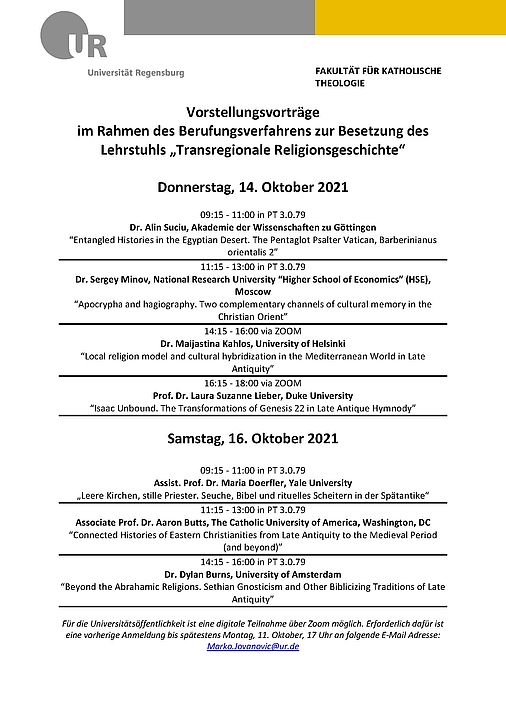
15.07.2021
International Presidential Visiting Scholar Fellow aus Israel zu Gast an der UR
Der Präsident der Universität Regenburg, Prof. Dr. Udo Hebel, konnte am 8. Juli 2021 mit Prof. Haim Weiss, dem Leiter der Abteilung für hebräische Literatur an der Ben-Gurion-Universität des Negev in Be'er Scheva, Israel – seit 2019 Partneruniversität der UR – nach pandemiebedingter Verschiebung den International Presidential Visiting Scholar Fellow 2020 an der Universität Regensburg willkommen heißen. „Trotz der mit der Pandemie verbundenen Einschränkungen bestanden internationale Kontakte und die grenzüberschreitende Zusammenarbeit unserer Wissenschaftler:innen auch in den vergangenen Monaten selbstverständlich fort. Aber dennoch freut es mich außerordentlich, mit Prof. Haim Weiss einen hoch renommierten Kollegen endlich auch wieder vor Ort an der Universität Regensburg willkommen heißen zu können!“ so Präsident Prof. Dr. Hebel.
Das International Presidential Visiting Scholar Fellowship wird jährlich vergeben und ermöglicht den Forschungs- und Lehraufenthalt von international renommierten Wissenschaftler:innen an der Universität Regensburg.
Prof. Weiss, dessen Forschung sich auf die rabbinische Literatur konzentriert und dabei u. a. auch deren komplizierte Verbindungen mit der modernen hebräischen Kultur untersucht, arbeitet während seines Aufenthalts an der Universität Regensburg mit seinen Kolleg:innen der interdisziplinären DFG-Kolleg-Forschungsgruppe 'Jenseits des Kanons: Heterotopien religiöser Autorität im spätantiken Christentum' zusammen.
Diese Forschungsgruppe, als deren Sprecher Prof. Dr. Tobias Nicklas (Lehrstuhl für Biblische Theologie - Exegese und Hermeneutik des Neuen Testaments) fungiert, wird seit 2018 von der Deutschen Forschungsgemeinschaft (DFG) mit knapp vier Millionen Euro gefördert und kooperiert dabei mit Spitzenforscher:innen aus der ganzen Welt, die als Fellows z. T. auch eine Zeit lang vor Ort an der Universität Regensburg tätig sind.
Spacer
Neben den Forschungs- und Lehraktivitäten ist eine Public Lecture Bestandteil des IPVS-Fellowships. Prof. Weiss ging in seinem virtuellen Vortrag „The book of Legend: from Rabbinic Literature to Zionism“ am 8. Juli auf die Art und Weise ein, wie die rabbinische Kultur und Literatur in modernen literarischen Anthologien dargestellt wird: Was bleibt im Transformationsprozess gleich, was wird verändert und was wird ganz weggelassen? Als Fallbeispiel fungierte „The Book of Legend“, die einflussreichste moderne Anthologie, die zu Beginn des 20. Jahrhunderts von Hayim Nahman Bialik und Yehoshua Hana Rawnitzki in Odessa herausgegeben wurde. Gleich nach deren Veröffentlichung wurde diese zum Tor, durch welches viele moderne jüdische und israelische Leser:innen auf ihre eigene Vergangenheit blickten. Es ist aber, wie es Prof. Weiss eindrucksvoll darzulegen gelang, ein komplexes Tor, das Fragen über die Rolle der Vergangenheit im Prozess der Gestaltung der modernen nationalen Identität aufwirft.
09.07.2021
Prof. Dr. Nina Glibetić Fellow of the Humboldt Foundation
The Humboldt Foundation has granted Prof. Dr. Nina Glibetić (University of Notre Dame, IN) a Humboldt Research Fellowship for Experienced Researchers at the Chair of Liturgical Studies. Prof. Glibetić has already been a guest, as an Adjunct Fellow at the Centre for Advanced Studies "Beyond Canon_", for several times; her project on "A Levitical Renaissance in Byzantium: Clergy, Women, Purity, and Sacred Space in Late Medieval Christian Liturgy" strengthens the research focus of the chair in the area of Byzantine liturgy, which is also profiled due research of other Humboldt Fellows and scholars with DFG own positions. On the one hand that makes an outstanding contribution to the faculty research focus in the area of the "Bible and its Reception in Cultural Discourses", whereas on the other hand it gives a clear profile to regional research in liturgical studies and thus to the area studies that shape the profile of the University of Regensburg.
Dr. Paweł Figurski Fellow of the Humboldt Foundation
The Humboldt Foundation has granted Dr. Paweł Figurski (Academy of Sciences, Warsaw) a Humboldt Research Fellowship for Postdoctoral Researchers at the Chair of Liturgical Studies. His project - which is also critical in terms of ideology - on "Medieval Liturgy and the Making of Poland. A Study in Medieval State-Formation, Peace-Building, and Strategies of Identification (until c. 1300)" fits into the research context in the field of medieval liturgy as well as in the Forum Mittelalter, which has also been identified through other projects, and makes a methodologically innovative contribution to the area studies in the field of Eastern European research that shape the profile of the University of Regensburg.
12.04.2021
Eigene Stelle der DFG für Prof. Dr. Stefano Parenti
Die DFG hat Prof. Dr. Stefano Parenti zum zweiten Mal in Folge eine Eigene Stelle bewilligt. Prof. Parenti, der kürzlich eine monumentale Monographie über "L'anafora di Crisostomo: Testi e contesti" (Münster 2020) vorgelegt hat und seit 2018 am Lehrstuhl für Liturgiewissenschaft an einer "Regional History of the Byzantine Rite" arbeitet, die einen innovativen Beitrag einerseits zur vormodernen Metropolitätsforschung, andererseits zu den Area Studies leistet, gehört zu den weltweit führenden Spezialisten der orientalischen Liturgiewissenschaft. Sein neues Projekt über "A History of the Byzantine Divine Liturgy: The Synaxis of the Word" ergänzt diesen Forschungskontext in idealer Weise und fügt sich insbesondere zu den laufenden Projekten der vier Humboldt-Fellows Dr. Ramez Mikhail, "The Ritual Celebration fo Scripture from Late Antique to Medieval Egypt", Prof. Dr. Gabriel Radle, "The Ritual of an Empire: Life-Cycle Liturgies at Constantinople", Dr. Evan Freeman, "Appropriating the Past: Art, Ritual, and Identity in Later Byzantium" und Dr. Alexandra Nikiforova, "The Triodion between Jerusalem and Constantinople".
22.03.2021
BCJ.Bayern-Studienpreis für Marko Jovanović
M.Theol. Marko Jovanović, Wissenschaftlicher Mitarbeiter und Lehrstuhlkoordinator am Lehrstuhl für Alte Kirchengeschichte und Patrologie sowie Wissenschaftlicher Mitarbeiter an unserem Centre for Advanced Studies "Beyond Canon_" hat für seine von Prof. Dr. Tobias Nicklas betreute Magisterarbeit "Franz Mußners Auslegung des Jakobusbriefes in Bezug auf den jüdisch-christlichen Dialog" den ersten Platz des BCJ.Bayern-Studienpreises 2021 in der Kategorie "Universität I" belegt.
BCJ.Bayern e.V.
Inzwischen vertieft und erweitert Herr Jovanović seine einschlägigen Untersuchungen im Rahmen einer Dissertation zum Thema "Juden und Christen: Getrennte Wege oder verflochtene Linien? Ein forschungsgeschichtlicher Aufriss".
Wir gratulieren ihm von ganzem Herzen zu dieser verdienten Auszeichnung!
02.02.2021
Call for Application: Professorship for Transregional History of Religions
Our university offers a new professorship for Transregional History of Religions: Processes of Formation and Interaction among Religious Movements since Late Antiquity.
Please find more information in attachment and here: https://www.uni-regensburg.de/universitaet/stellenausschreibungen/professuren/index.html
The professorship is being created to strengthen our Centre for Advanced Studies – a clear sign of appreciation from our university. It is a permanent position, with the legal status of a civil servant for life.
Our university is strongly encouraging international applications; neither a canonical theology degree nor teaching in Catholic theology are compulsory.
Please send this call for applications around in your networks. The Dean of our Faculty for Catholic Theology, Prof. Dr. Harald Buchinger (harald.buchinger@ur.de) is at your disposal for further information.
14.12.2020
Eigene Stelle der DFG für Junior Fellow DDr. Predrag Bukovec
Die DFG hat Dr. Predrag Bukvoec, PhD, derzeit Ass.-Prof. an der KU Linz, für drei Jahre eine Eigene Stelle für seine Forschung "Zu den Ursprüngen der Taufsalbung" bewilligt. Dr. Bukovec war nach seinen Promotionen zum Dr. theol. und PhD an der Universität Wien Fellow am Centre for Advanced Studies "Beyond Canon_" und habilitiert sich an der Universität Regensburg. Das Centre for Advanced Studies "Beyond Canon_" erweist sich durch die Agglomeration weiterer Drittmittelprojekte als nachhaltig strukturbildend.
09.10.2020
BEyond Canon Summer School Rom - SEptember 2021
Bewerben Sie Sich noch bis zum 31.12.2020 für die Beyond Canon_ Summer School in Rom im September 2021. Mehr Infos Finden Sie in unserem Veranstaltungskalender
12.02.2020
Professor Stefanos Alexopoulos erhält ein Dumbarton Oaks Research Fellowship
Unserem Senior Fellow Rev. Stefanos Alexopoulos, PhD (The Catholic University of America) wurde für 2020/2021 eines der renommierten Dumbarton Oaks Reserach Fellowships zugesprochen. Unser Centre gratuliert ihm dazu herzlich!
20.10.2019
DDr. Predrag Bukovec mit Armin-Schmitt-Preis 2019 ausgezeichnet
Die zweite Dissertation über "Mahl und Mähler: Die frühchristliche Eucharistie (1.-3. Jahrhundert)" unseres Junior Fellows DDr. Predrag Bukovec wird mit einem weiteren Preis bedacht, dem Armin-Schmitt-Preis 2019 - wir gratulieren ihm herzlich!
Weitere Informationen finden Sie hier: http://www.armin-schmitt-stiftung.de/preistraeger/2019.html
20.09.2019
DDr. Predrag Bukovec erhält den Kardinal-Innitzer-Förderungspreis
DDr. Predrag Bukovec, derzeit Junior Fellow unseres Centre for Advanced Studies "Beyond Canon_" und Habilitand am Lehrstuhl für Liturgiewissenschaft unserer Fakultät für Katholische Theologie, erhält nach dem Promotionspreis der Katholisch-Theologischen Fakultät der Universität Wien und dem Roland-Atefie-Preis der Österreichischen Akademie für Wissenschaften für seine erste Dissertation nun den Kardinal-Innitzer-Förderungspreis für Theologie 2019 für seine zweite Dissertation über "Mahl und Mähler: Die frühchristliche Eucharistie (1.-3. Jahrhundert)".
Wir freuen uns mit ihm und gratulieren herzlich!



